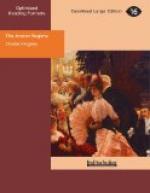Consider that word, “picturesque.” It, and the notion of art which it expresses, are the children of the Ancien Regime—of the era of decay. The healthy, vigorous, earnest, progressive Middle Age never dreamed of admiring, much less of painting, for their own sake, rags and ruins; the fashion sprang up at the end of the seventeenth century; it lingered on during the first quarter of our century, kept alive by the reaction from 1815-25. It is all but dead now, before the return of vigorous and progressive thought. An admirer of the Middle Ages now does not build a sham ruin in his grounds; he restores a church, blazing with colour, like a medieval illumination. He has learnt to look on that which went by the name of picturesque in his great-grandfather’s time, as an old Greek or a Middle Age monk would have done—as something squalid, ugly, a sign of neglect, disease, death; and therefore to be hated and abolished, if it cannot be restored. At Carcassone, now, M. Viollet-le-Duc, under the auspices of the Emperor of the French, is spending his vast learning, and much money, simply in abolishing the picturesque; in restoring stone for stone, each member of that wonderful museum of Middle Age architecture: Roman, Visigothic, Moslem, Romaine, Early English, later French, all is being reproduced exactly as it must have existed centuries since. No doubt that is not the highest function of art: but it is a preparation for the highest, a step toward some future creative school. As the early Italian artists, by careful imitation, absorbed into their minds the beauty and meaning of old Greek and Roman art; so must the artists of our days by the art of the Middle Age and the Renaissance. They must learn to copy, before they can learn to surpass; and, meanwhile, they must learn—indeed they have learnt—that decay is ugliness, and the imitation of decay, a making money out of the public shame.
The picturesque sprang up, as far as I can discover, suddenly, during the time of exhaustion and recklessness which followed the great struggles of the sixteenth century. Salvator Rosa and Callot, two of the earliest professors of picturesque art, have never been since surpassed. For indeed, they drew from life. The rags and the ruins, material, and alas! spiritual, were all around them; the lands and the creeds alike lay waste. There was ruffianism and misery among the masses of Europe; unbelief and artificiality among the upper classes; churches and monasteries defiled, cities sacked, farmsteads plundered and ruinate, and all the wretchedness which Callot has immortalised—for a warning to evil rulers—in his Miseres de la Guerre. The world was all gone wrong: but as for setting it right again—who could do that? And so men fell into a sentimental regret for the past, and its beauties, all exaggerated by the foreshortening of time; while they wanted strength or faith to reproduce it. At last they became so accustomed to the rags and ruins, that they looked on them as the normal condition of humanity, as the normal field for painters.




